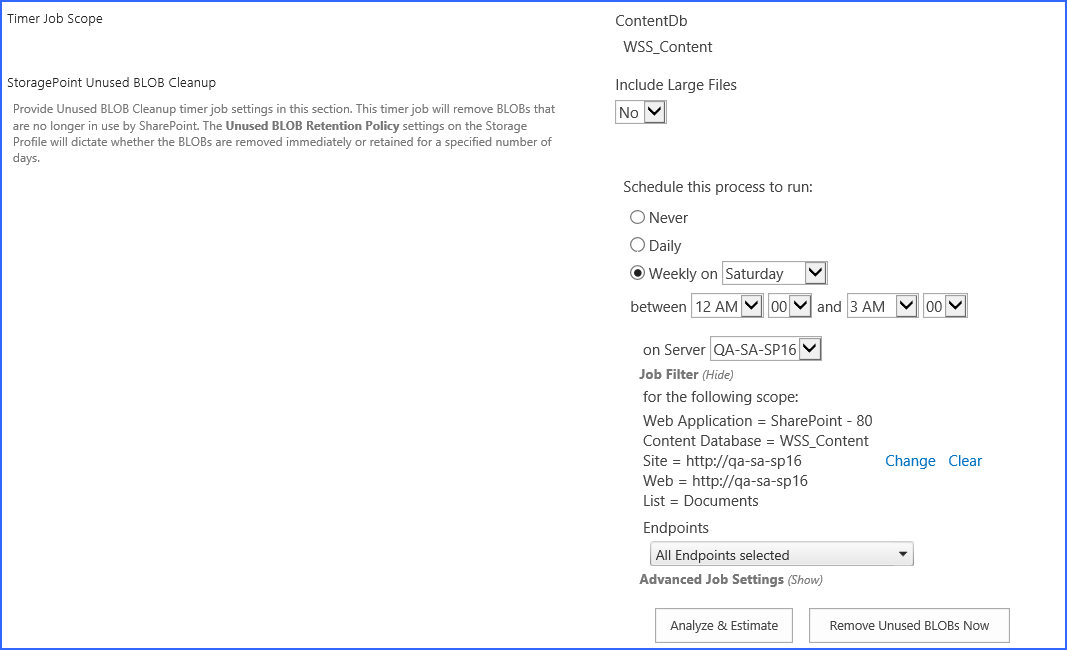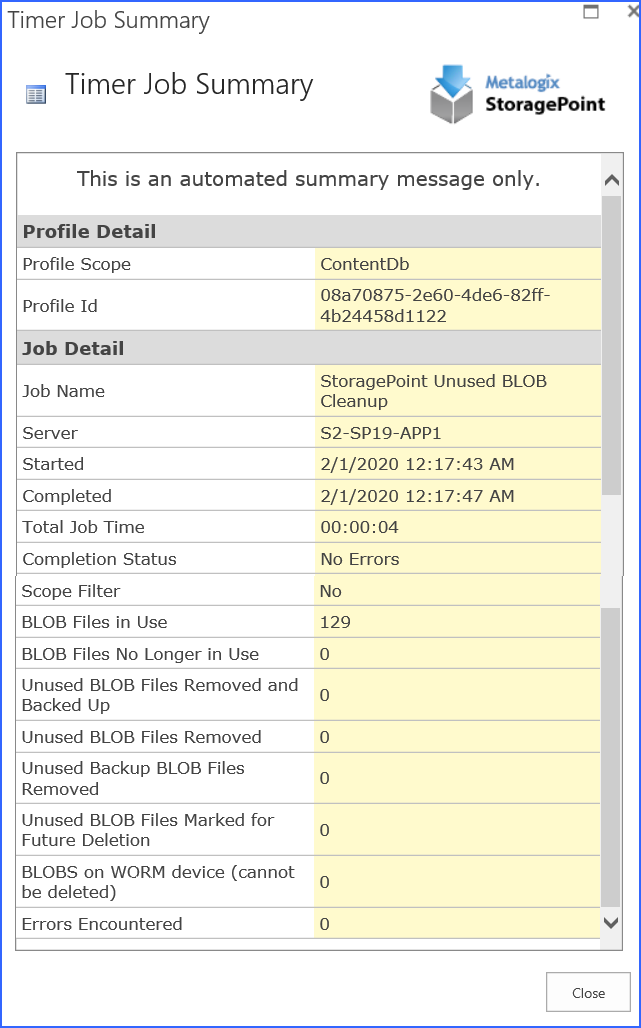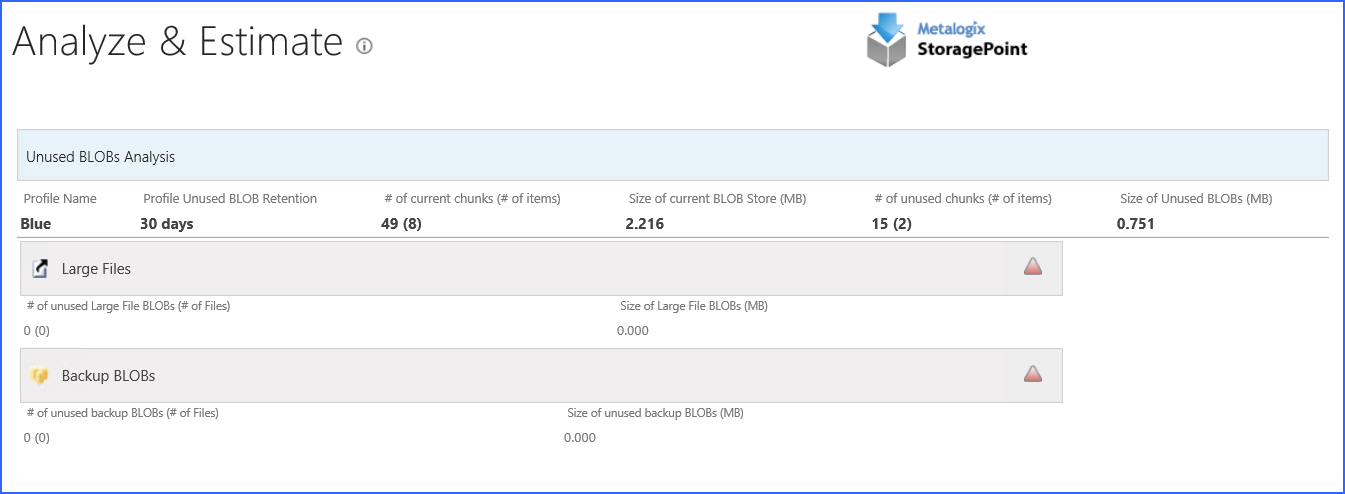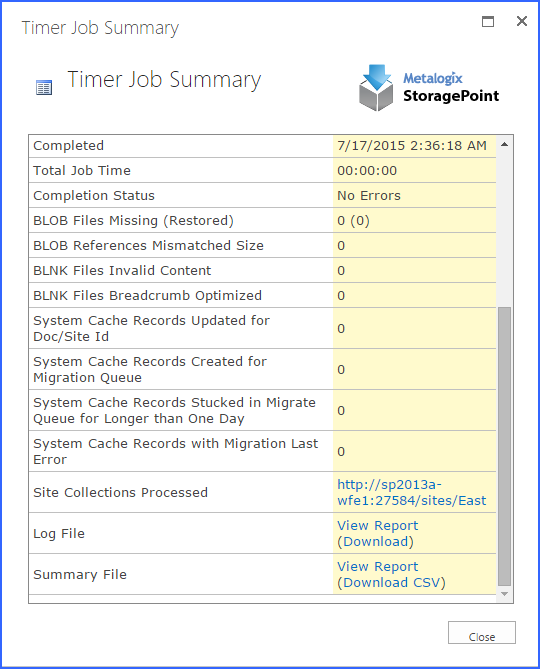Unused BLOB Cleanup
This job will remove BLOBs from the BLOB store(s) associated with the storage profile that are no longer referenced in SharePoint. It can be configured to run Daily or Weekly at a certain time. This job is scheduled by default when a profile is created. The job can also be run immediately by clicking Remove Unused BLOBs Now. Please refer to Unused BLOB Cleanup Job Considerations for more information.
·If Large File Support is enabled, the Unused BLOB Cleanup job scans all content for orphaned BLOBs. This can be disabled by selecting No in the first dropdown.
·If a Site Collection has recently been deleted, SharePoint doesnt delete it until the Gradual Site Delete timer job has been run. The Unused BLOB Cleanup job may return errors until the deleted site collection is removed by SharePoint. It is recommended that the Gradual Site Delete timer job be run manually, after deleting a Site Collection.
·If the filter is used on a Manually Initiated Job (Remove Unused BLOBs Now), it will not be retained for scheduled jobs, unless the timer job is saved.
·Due to SQL limitations, adding a hierarchy scope eliminates the system cache from the scope of the timer job. To remedy this, run the job without a filter.
To configure the Unused BLOB Cleanup job:
1.Note the Timer Job Scope (at the top of the page) of the Storage Profile selected.
2.Select Yes or No for Include Large File Scanning. Yes will include the BLOBs and stubs created while using the Large File Upload in the scan for content to be removed. No (default) will ignore them.
3.(Optional) If Yes was selected for Include Large Files, click the Scan Only Large Files to only analyze Large File Uploads within the profile.
4.Select the Never, Daily, or Weekly on option.
5.For Weekly, select the day of the week from the supplied dropdown.
6.For Daily or Weekly, select the start window time from the between dropdowns and the end window time form the and dropdowns.
7.(Optional) On the on Server dropdown list, select the WFE server to run the job on.
8.(Optional) Click the Show link next to Job Filter. Click Change to open the scope selection window. By default the entire scope of the profile is included. Select a scope from within the profile scope to narrow down the amount of data the timer job will have to process. Click Ok.
Use the Change link to modify a filter and the Clear link to remove a filter.
9.(Optional) On the Job Filter dropdown, select one, multiple, or all (default) endpoints.
10.(Optional) Click the Show link next to the Advanced Job Settings to view notification settings.
11.Under the Send Completion Notice: header, select whether the email notification should go out Always, or Only when errors occur.
12.(Optional) In the To section:
a.Check the Default Notifications Contacts box to have a completion email sent to the email address entered in General Settings. Note that for this feature to work, the Default Notification field on General Settings must contain a valid email address.
b.In the Additional Contacts box, enter a semi-colon delimited list of other email addresses that should receive the notification.
13.Click Save to save the configured job schedule.
14.(Optional) Click Remove Unused BLOBs Now, to begin the timer job immediately.
|
|
NOTE: Endpoints on a WORM device will be ignored by the Unused BLOB Cleanup Job. |
The Unused BLOB Cleanup Job summary, found on the Job Status page, will provide details on what was removed, marked for future deletion, and what is still in use.
The Unused Blob Cleanup summary will reset the counts after each run and are not cumulative.
|
BLOB Files in Use |
File exists in SharePoint (site or recycle bins) |
|
BLOB Files No Longer in Use |
File is out of SP, but has not been backed up. OR BLOB was recalled. |
|
Unused BLOB Files Removed and Backed Up |
Files that are out of SP, but a backup has been created. |
|
Unused BLOB Files Removed |
File is out of SP and profile retention has expired. |
|
Unused Backup BLOB Files Removed |
File is out of SP and backup retention has expired. |
|
Unused BLOB Files Marked for Future Deletion |
File is out of SP, but profile retention hasn't expired. |
|
BLOBs on WORM Device (cannot be deleted) |
Endpoint is marked as WORM. |
|
*out of SP = file is removed from folder and any SharePoint recycle bins |
Unused BLOB Cleanup – Analyze & Estimate
To display an estimate of the number of BLOBs no longer in use and therefore ready to be removed:
1.Click Analyze and Estimate.
2.The estimates for all content databases covered by the scope of the profile will be displayed, showing how many BLOBs could be removed by running the timer job.
3.Click Back to return to the Timer Jobs screen.
BLOB Health Analyzer
The BLOB Health Analyzer tool looks at the BLOBs for the profile to check for inconsistencies such as missing BLOB files, BLOB reference size mismatches, or invalid BLNK files. This timer job may have been configured to run weekly, when the profile was first created.
1.Note the Timer Job Scope of the Storage Profile selected.
2.Select Yes or No (default) to also scan Large Files. Selecting Yes may impact job performance. No (default) will ignore them.
3.(Optional) If Yes was selected for Include Large Files, click the Scan Only Large Files to only analyze Large File Uploads within the profile.
4.Select the Never, Daily, or Weekly on option.
5.For Weekly, select the day of the week from the supplied dropdown.
6.For Daily or Weekly, select the start window time from the between dropdowns and the end window time form the and dropdowns.
7.(Optional) On the on Server dropdown list, select the WFE server to run the job on.
8.(Optional) Click the Show link next to Job Filter. Click Change to open the scope selection window. By default the entire scope of the profile is included. Select a scope from within the profile scope to narrow down the amount of data the timer job will have to process. Click Ok.
Use the Change link to modify a filter and the Clear link to remove a filter.
9.(Optional) Click the Show link next to the Advanced Job Settings to view notification settings.
10.Under the Send Completion Notice: header, select whether the email notification should go out Always, or Only when errors occur.
11.(Optional) In the To section:
a.Check the Default Notifications Contacts box to have a completion email sent to the email address entered in General Settings. Note that for this feature to work, the Default Notification field on General Settings must contain a valid email address.
b.In the Additional Contacts box, enter a semi-colon delimited list of other email addresses that should receive the notification.
12.Check the Restore Missing BLOBs checkbox to restore BLOBs from the backup endpoint, to the current endpoint. Only files that exist in SharePoint that are found to have their BLOBs missing will be restored.
13.Click Save to save the configured job schedule.
14.(Optional) Click Process BLOB Health Analyze Now to begin the job immediately.
The summary of the timer job, found on the Timer Job Status page, will list any inconsistencies found.
The Log File and Summary File can be viewed in a browser window by clicking View Report.
The Download CSV link will download a text file of the respective report.
The Log File contains information regarding the overall status of the scan.
The Summary File will contain details about BLOBs that have generated inconsistencies.
Externalize and Recall Job Considerations









